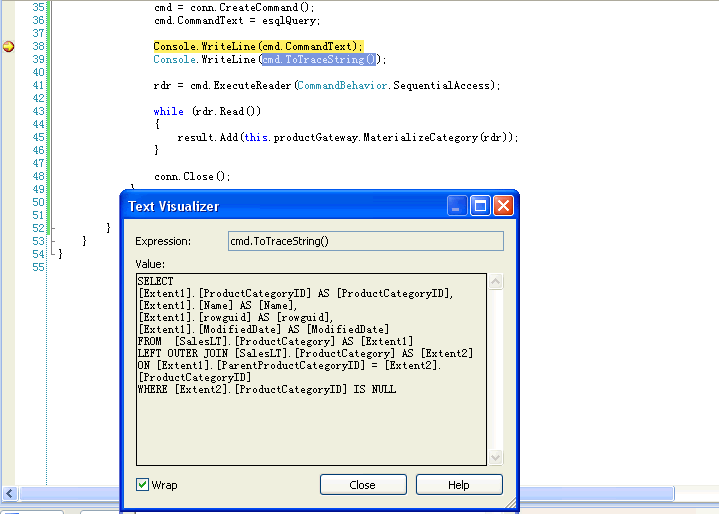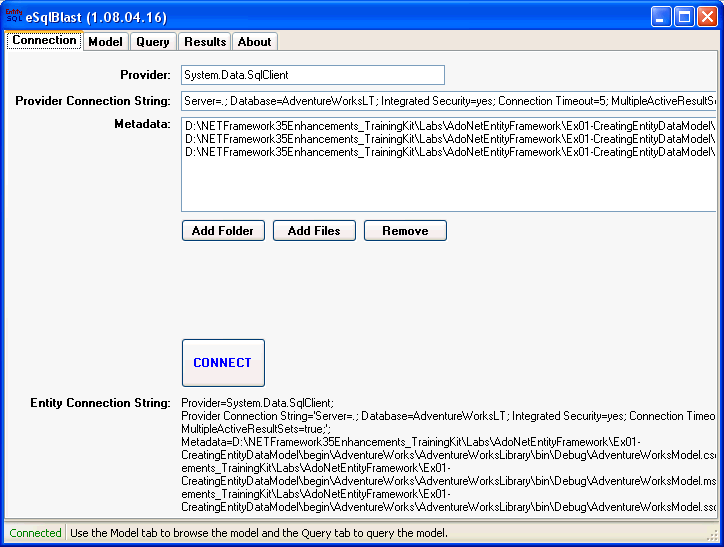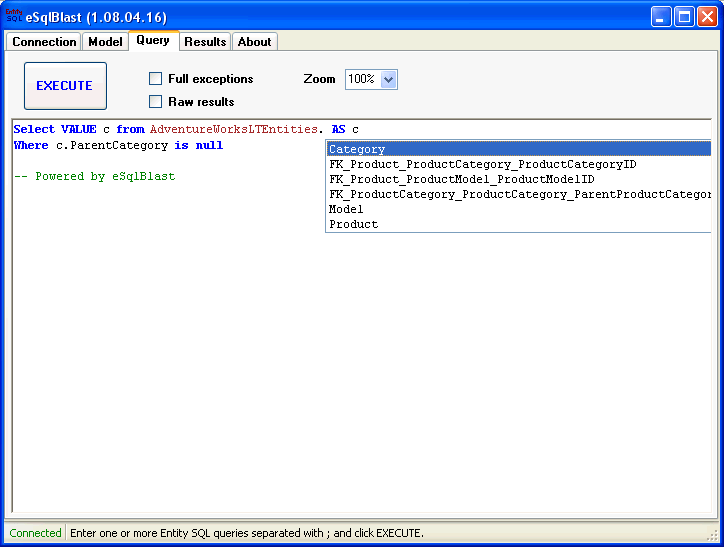前面的Part 1-3的文章,介绍了Entity Data Model、Entity
SQL、ObjectQuery、EntityCommand、LINQ to Entities等等及其代码演示。这篇文章主要演示如何通过相关技术或Debug工具,如SQL
Server Profiler、ToTraceString 方法、eSqlBlast
工具、LINQPad工具等等,来查看生成的T-SQL脚本。
Entity Data Model 是一个概念模型,所有Entity SQL和LINQ
to Entities 查询将最终转化为T-SQL的脚本,从数据库中查询数据。这里演示了几种方法来查看生成的T-SQL,有助于Debug或分析问题。
1. 使用SQL Server Profiler 工具
与LINQ to SQL比较而言,ObjectContext 类没有提供Log属性或者通用的log机制,因此,无法在Visual
Studio 中跟踪所有的T-SQL语句。
如果你想查看所有执行的T-SQL语句,你需要使用SQL Server的Profiler
工具,关于具体如何使用SQL Server Profiler工具,请参考如下文章:
SQL Profiler: Features, functions and
setup in SQL Server 2005
2. ToTraceString 方法
另外一种方法去查看生成的T-SQL语句的方法,包括 EntityCommand和ObjectQuery类都有一个ToTraceString()
方法。在一些情况下,可以用来查看内部到底生成什么SQL脚本,而不必一定要使用SQL
Server Profiler 工具。需要注意的是:ToTraceString()
方法实际上没有执行查询操作,仅仅是转化查询为SQL脚本。
通过增加一个断点,你可以轻松查看SQL脚本,需要记住的是:事先需要打开数据库连接,否则会抛出InvalidOperationException
异常(Execution of the command requires an
open and available connection. The connection’s
current state is closed.)
(1)Entity SQL : EntityCommand.ToTraceString()
示例脚本
public IList<Category>
GetParentCategory()
{
IList<Category>
result = null;
EntityDataReader
rdr;
EntityCommand
cmd;
string esqlQuery;
using (EntityConnection
conn = new
EntityConnection("name=AdventureWorksLTEntities"))
{
conn.Open();
esqlQuery =
@"Select VALUE c from AdventureWorksLTEntities.Category
AS c
Where c.ParentCategory is null ";
result = new
List<Category>();
cmd = conn.CreateCommand();
cmd.CommandText = esqlQuery;
Console.WriteLine(cmd.CommandText);
Console.WriteLine(cmd.ToTraceString());
rdr = cmd.ExecuteReader(CommandBehavior.SequentialAccess);
while (rdr.Read())
{
result.Add(this.productGateway.MaterializeCategory(rdr));
}
conn.Close();
}
return result;
}
示例界面如下:

(2)Entity SQL : ObjectQuery.ToTraceString()
示例脚本如下:
NorthwindEntities context = new NorthwindEntities();
var sql = "SELECT VALUE emp FROM
NorthwindEntities.Employees AS emp "
+
"WHERE emp.Country = @country";
var query = context.CreateQuery<Employee>(sql);
query.Parameters.Add(new ObjectParameter("country",
"USA"));
if (context.Connection.State != ConnectionState.Open)
context.Connection.Open();
Console.WriteLine(query.ToTraceString());
(3)LINQ to Entities : (query as ObjectQuery).ToTraceString()
示例脚本
需要使用类型转换,将LINQ to Entities (IQueryable)
查询转化为ObjectQuery,这样就可以调用ToTraceString()
方法了。
NorthwindEntities context = new NorthwindEntities();
string country = "USA";
var query = from e in context.Employees
where e.Country == country
select e;
if (context.Connection.State != ConnectionState.Open)
context.Connection.Open();
Console.WriteLine((query as ObjectQuery<Employee>).ToTraceString());
也可以通过反射(Reflection)和Invoke() 方法,得到相同的结果:
Console.WriteLine(query.GetType().GetMethod("ToTraceString").Invoke(query,
null));
3. 使用eSqlBlast 工具
微软也提供了一个免费的工具来帮助学习Entity SQL。
eSqlBlast 的下载地址(含有源代码,需要自己编译一下)及其相关介绍(eSqlBlast
for VS 2008 SP1):
如果懒得编译,可以直接在本文章底部点击下载链接,下载已经编译好的可执行文件。
运行界面如下:

Connection 页面用来指定3个元数据文件(CSDL/SSDL/MSL)和数据库连接字符串。数据库连接字符串可以直接从App.config
复制过来。点击Connect 按钮进行连接。
Model 页面用来显示所有的EntitySets和EntityTypes。

Query 页面可以输入 Entity SQL脚本,你会注意到eSqlBlast
支持智能提示(IntelliSense),酷吧!!!目前,Visual Studio
2008 sp1 尚不支持Entity SQL 的职能提示呢。

点击Execute 执行按钮,执行结果将以HTML的格式显示在Results
页面,如下图所示。包括4个部分:Enttiy Command (也就是CommandText
属性值)、Store Command(生成的T-SQL脚本,也就是ToTraceString()
方法产生的脚本)、Record Count(结果集的记录数)、Data(实际记录结果)。

LINQPad 是一个优秀的LINQ 表达式测试工具,原本设计用来执行LINQ
to Objects 和LINQ to SQL查询,但是也可以用来执行LINQ
to Entities 查询。
如下图所示,执行LINQ to SQL查询,并调用扩展方法Dump() 输出结果。

LINQPad 免费工具可以到如下地址下载:
 点击下载
示例程序 AdventureWorks_EntityFrameworkDemo_v2
(356 KB)
点击下载
示例程序 AdventureWorks_EntityFrameworkDemo_v2
(356 KB)